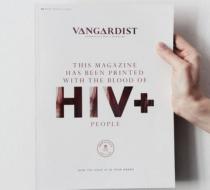Vangardist HIV+ Magazine Favorite
HIV is still among the top 10 leading causes of death in the world, ranking sixth with around 1.5 million deaths each year. Around 35 million people are currently infected with HIV, and cases are worryingly on the rise—it is far from old news. Determined to change this, a magazine has embarked on a bold new campaign in which 3,000 copies will be printed using ink mixed with HIV-infected blood.
The idea behind the original project, headed by “progressive men’s magazine” Vangardist and global comms agency Saatchi & Saatchi Switzerland, is set to reignite much needed conversation about HIV and AIDS and to tackle the stigma surrounding the virus.
“There’s been an 80 percent increase in HIV in the last 10 years—that’s according to the World Health Organization—and that’s pretty shocking,” said Jason Romekyo, Executive Creative Director of Saatchi & Saatchi Switzerland. “The reason why that’s happening is people just aren’t talking about it anymore.”
The provocative editions were created using ink infused with the blood of three infected individuals, hailed by the magazine as “HIV heroes,” all of whom have very different backgrounds: a 26-year-old gay man from Berlin, a 32-year-old straight man and a 45-year-old mother of two. As pointed out by publisher and CEO of Vangardist Julian Wiehl, two of these do not fit the typical stereotype associated with the virus, something the magazine understandably wants to accentuate.
“If you see the magazine… the first question that comes to your mind is, ‘Would I touch it? Would I take it in my hands?’” Wiehl said in an interview. “And the second question is, ‘Why would I touch it?’ or ‘Why wouldn’t I touch it?’” By encouraging people to hold HIV in this unique manner, Vangardist hopes that fears over contacting someone infected with the virus can be overcome. “It will make you reflect on HIV and you will think differently afterwards. Because now the issue is in your hands,” Wiehl wrote.
While the idea of touching HIV-infected blood may arouse raised eyebrows in many, there is of course absolutely no risk of infection from the magazine. To create the editions, Saatchi & Saatchi’s website writes that strict controls and processes were developed using guidelines established by Harvard and Innsbruck University guidelines. After the blood was donated, it was heat treated to inactivate the virus and then mixed to a ratio of 1 part blood and 28 parts ink. This unique blend was then used to print every word and image of every single page, creating 3,000 special copies, priced at €50 ($55). Profits will go to charities dedicated to tackling the stigma surrounding HIV, according to Mashable.







